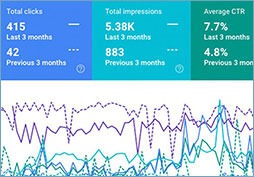While they may seem like completely separate disciplines, the fact is that there are a number of startling similarities between these two art forms. And as someone who has been designing websites for more than 25 years, and writing songs for longer than that, I should know! Let’s compare them.

Creativity within a set format

In neither case do you start with a completely “blank canvas.” In the case of designing websites, you are constrained by a number of factors, including (but most certainly not limited to):
- Devices on which they would be viewed (Desktop computer, cell phone, tablet, etc.)
- Conventions like never having to scroll right and left
- Text that is large enough to be legible, and contained within column widths that are comfortably readable
- Bite sized pieces of information that are easily digestible
Believe it or not, the restrictions on songwriting are even more rigorous. To name a few:
- A playing length of not less than 2:45, and not more than five minutes
- Accepted structures such as verse, chorus, verse, chorus, bridge, chorus
- With rare exceptions, a rhythmic pattern in 4/4 time
- Lyrics that are grammatically correct (for the most part), simple to understand and remember, and relevant
So even before you begin, you have boundaries within which you must stay in order for your product (either song or site) to be acceptable to the general public.
Emotional impact

Music is obviously a very emotionally charged art form. Every listener understands that different songs affect them in different ways, according to the song itself and the history they have with it. As a songwriter, if you want to be successful you must understand how to have that kind of impact. It doesn’t matter how a song makes you, as the writer, feel; what matters is the emotions it generates in your listeners.
Although it is not as obvious to most people, websites are also designed to drive an emotional response. When users go to your website, they are constantly evaluating you and your company through the window of the site, and forming opinions and value judgments about the business.
In both cases, because these visceral responses are in large part subconscious, they are all the more powerful. People don’t know why they feel a certain way about your song or your company, but they do nonetheless. The fact that it is not a logical, conscious reaction makes it virtually impossible to dislodge once it has taken root.
Logical processes

While it may seem like memorable songs and pleasing websites spring ”magically” from some deep well of creativity within the writer/designer, nothing could be farther from the truth.
Most good songs are crafted, and the more experience and the larger the toolbox of techniques the songwriter has, the better the job they can do. This can be as simple as employing well-known idioms in the language, or as complex as knowing how to incorporate key changes and what sort of motifs and chord progressions work well together.
Likewise, effective websites aren’t just “thrown together because they look cool.” Color selections and combinations, font choices, photos, graphical elements, and more are carefully chosen both for the impact each will have as a single unit, and how well they work together. There is a rule in design which states “the simpler the design, the more difficult it is to create.”
Timelessness

Website design moves at the pace of technology: unbelievably quickly. Sometimes it seems as if every year, month — and sometimes week — ushers in a new phase of website design. And while it is good to stay up on the state of the art, the danger is that falling prey to “hot” trends will render your site stale in a relatively short period of time.
The savvy website designer pulls specific elements from the current styles, and blends them into a pleasing whole. Done correctly, this will keep a website looking fresh and current for a much longer period of time.
Similarly, song writers can get caught in the same eddy of whirling fads. But well-written songs that avoid too many clichés never go out of style. Just compare some of the “hip” songs from the disco and new wave eras of the ‘70s and ‘80s with classics such as Eric Clapton’s seminal tune, “Layla,” and you get the point.
So if you are looking for your website to be designed by someone who really knows their craft, try a songwriter. You will be pleasantly surprised!








